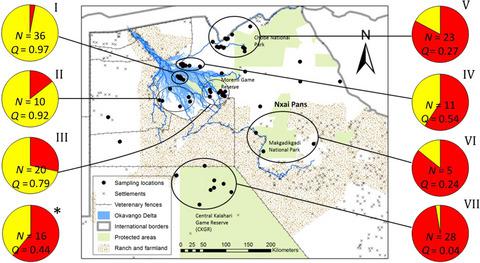当前位置:
X-MOL 学术
›
Anim. Conserv.
›
论文详情
Our official English website, www.x-mol.net, welcomes your
feedback! (Note: you will need to create a separate account there.)
Ecology rather than people restrict gene flow in Okavango‐Kalahari lions
Animal Conservation ( IF 2.8 ) Pub Date : 2020-01-27 , DOI: 10.1111/acv.12562 S. G. Dures 1, 2 , C. Carbone 1 , V. Savolainen 2 , G. Maude 3 , D. Gottelli 1
Animal Conservation ( IF 2.8 ) Pub Date : 2020-01-27 , DOI: 10.1111/acv.12562 S. G. Dures 1, 2 , C. Carbone 1 , V. Savolainen 2 , G. Maude 3 , D. Gottelli 1
Affiliation

|
Reduced gene exchange between animal populations may be an indicator of the effects of anthropogenic fragmentation or it may reflect natural gradients in the landscape that can also result in population fragmentation. It can be difficult, therefore, to disentangle the role of local ecology from anthropogenic factors, creating a risk of attributing a lack of gene flow as being due to human activities, leading to ill‐informed management decisions. Here, we test the ecological and anthropogenic factors driving population differentiation and show how the relative influence of such effects can be identified. Using Bayesian clustering and a causal modelling approach, we combine genetic and remote sensing data to disentangle the confounding influences of ecological and anthropogenic fragmentation. We investigate a region where such confusion may arise; in and around the Okavango Delta in northern Botswana. Specifically, we used 20 microsatellites to investigate the genetic structuring of African lions Panthera leo occupying a landscape dominated by two very different environments, the wetland Okavango and the surrounding Kalahari Desert. We find that differences in ecology, rather than anthropogenic barriers, are driving genetic differences in the population and that despite their ability to disperse long distances these lion populations are differentiated into two distinct genetic groups, one inhabiting the wetland Okavango Delta and the other one inhabiting the surrounding dryland Kalahari, divided by an apparently unobstructed boundary. The genetic structure observed could easily have been misinterpreted as a response to anthropogenic disturbance reducing gene flow. This reinforces the need to consider non‐anthropogenic hypotheses, such as ecological differences between habitats, when assessing possible mechanisms of gene flow and their implications for population management. As anthropogenic pressure increases in this region, we recommend conservation managers consider the Okavango population as a separate conservation unit, but also recognize the importance of maintaining the current structural landscape connectivity.
中文翻译:

生态而不是人类限制了Okavango-Kalahari狮子的基因流动
动物种群之间的基因交换减少可能是人为破碎作用的指示,或者可能反映了景观中的自然梯度,这也可能导致种群破碎。因此,可能难以将局部生态系统的作用与人为因素区分开来,存在归因于人类活动造成基因流不足的风险,从而导致管理决策不灵通。在这里,我们测试了驱动人口分化的生态和人为因素,并展示了如何识别这种影响的相对影响。使用贝叶斯聚类和因果建模方法,我们结合了遗传和遥感数据,以消除生态和人为破碎化的混杂影响。我们调查了可能引起这种混乱的地区;在博茨瓦纳北部的奥卡万戈三角洲及其周围地区。具体来说,我们使用了20个微卫星来研究非洲狮子的遗传结构豹狮子座占据了两个截然不同的环境主导的景观,湿地奥卡万戈和周围的卡拉哈里沙漠。我们发现,生态的差异而非人为的障碍正在推动种群的遗传差异,尽管它们能够分散很长的距离,但这些狮子种群仍被分为两个不同的遗传群体,一个栖息在湿地奥卡万戈三角洲,另一个栖息在周围的旱地卡拉哈里(Kalahari),被明显不受阻碍的边界所分隔。观察到的遗传结构很容易被误解为对人为干扰减少基因流的反应。这加强了考虑非人为假设的必要性,例如栖息地之间的生态差异,在评估基因流动的可能机制及其对人群管理的意义时。随着该地区人为压力的增加,我们建议养护管理人员将Okavango人口视为一个单独的养护单位,但也应认识到维持当前结构景观连通性的重要性。
更新日期:2020-01-27
中文翻译:

生态而不是人类限制了Okavango-Kalahari狮子的基因流动
动物种群之间的基因交换减少可能是人为破碎作用的指示,或者可能反映了景观中的自然梯度,这也可能导致种群破碎。因此,可能难以将局部生态系统的作用与人为因素区分开来,存在归因于人类活动造成基因流不足的风险,从而导致管理决策不灵通。在这里,我们测试了驱动人口分化的生态和人为因素,并展示了如何识别这种影响的相对影响。使用贝叶斯聚类和因果建模方法,我们结合了遗传和遥感数据,以消除生态和人为破碎化的混杂影响。我们调查了可能引起这种混乱的地区;在博茨瓦纳北部的奥卡万戈三角洲及其周围地区。具体来说,我们使用了20个微卫星来研究非洲狮子的遗传结构豹狮子座占据了两个截然不同的环境主导的景观,湿地奥卡万戈和周围的卡拉哈里沙漠。我们发现,生态的差异而非人为的障碍正在推动种群的遗传差异,尽管它们能够分散很长的距离,但这些狮子种群仍被分为两个不同的遗传群体,一个栖息在湿地奥卡万戈三角洲,另一个栖息在周围的旱地卡拉哈里(Kalahari),被明显不受阻碍的边界所分隔。观察到的遗传结构很容易被误解为对人为干扰减少基因流的反应。这加强了考虑非人为假设的必要性,例如栖息地之间的生态差异,在评估基因流动的可能机制及其对人群管理的意义时。随着该地区人为压力的增加,我们建议养护管理人员将Okavango人口视为一个单独的养护单位,但也应认识到维持当前结构景观连通性的重要性。











































 京公网安备 11010802027423号
京公网安备 11010802027423号